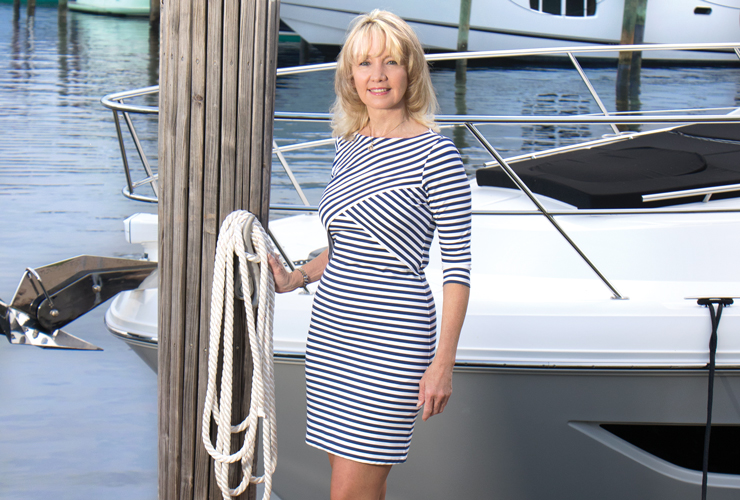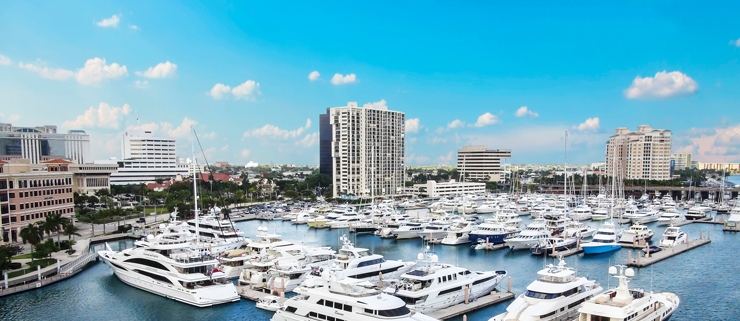Florida Marinas From Fort Lauderdale Through The Treasure Coast: Everything You Need To Know
Location. Location. Location. That old real estate mantra applies even when the land in question is not totally on the land. In assessing the quality of local marinas, one must consider not just the location, but the variables of the assessor, and more specifically, the boat one drives, and where one drives it.
And along Florida’s east coast, there is more than just water involved. Real estate development along waterways in more congested areas is altering the geography of the boating industry. And with dramatic expansion plans for passenger railroads coming to Florida’s east coast in the next few years, frequent drawbridge openings come into play as well. A marina location that is convenient today may be non-existent, or much less handy, a decade from now.
“It gets very specialized,” says Ginger Hornaday, a broker associate with the firm Engel & Völkers, whose beat is South Florida waterfront. She points out that the needs of a serious cruiser are different from those of a weekend boater. “There’s really three different marketing targets: There’s the guy with a boat 20 feet up to 60, and then 60 to 120 and 120 up to 200. And they tend to graduate up in each class. I have a client who brings his boat south to Miami in the winter. He says his dock is his condo.”
That’s one reason many marinas are catering to the larger boats, but at the same time, a market such as Fort Lauderdale is running out of space as developers increasingly buy up prime waterfront sites. Hornaday notes that repair facilities are moving farther west, along the Dania Cutoff Canal. The canal was built as a shortcut between the serpentine western reaches of the New River and Port Everglades. The industry is also migrating north to Palm Beach, St. Lucie and Martin counties.
Still, the Fort Lauderdale area easily leads South Florida in marine facilities. Julie Berry, a principal of Stiles Realty’s Marina Investments Group says, “Fort Lauderdale is the Yachting Capital of the World for good reason. It has miles of waterways; immediate access to the ocean from the protected inland waterways; the sport fishing is some of the best in the world; it has a host of activities and services for yachts and crew; it is close to the Caribbean and the depth is capable of handling superyachts, especially since the Intracoastal Waterway is being dredged to a 17-foot depth. The economic impact of the yachting industry in South Florida is $11.5 billion, of which $8.8 billion comes from Broward County.”
Last year, Berry sold one of the notable Fort Lauderdale facilities, Lauderdale Marine Center, to The Carlyle Group. It is the largest boatyard in the country, located on 60 acres along the New River near Interstate 95. It can accommodate 380 vessels of all sizes.
The emphasis on mega yachts at such convenient locations as Bahia Mar and neighboring Pier Sixty-Six on the Intracoastal Waterway—both a quick voyage to the busy Port Everglades Inlet—does not sit well with everybody, especially owners of smaller boats. Among them is Paul DeBold, a certified marine surveyor and long-time boating enthusiast.
“It’s all mega yacht driven,” he says. “Docks for the 50-foot boat are being ripped out to build what can take 150 feet. Fewer and fewer want to bother with a 35-foot boat. They want the boats that will spend thousands of dollars. It’s a difficult market in some places. West of I-95 there [are] some new places. Up in Palm Beach and beyond they’re recognizing that the average guy is getting pushed out of market. Some inlets can’t take larger yachts, so the smaller guy is their market.”
DeBold points out that the Mako Fishing Tournament, featuring smaller boats, moved because of declining interest in Miami and Fort Lauderdale. “Then they took it up to Jensen Beach (in Martin County) and every year it’s growing—somewhere close to 100 boats at the last tournament,” he says.
Hornaday recognizes that the industry is trending north; so is she, moving her license to the Engel & Völkers office on Palm Beach’s Worth Avenue.

Access to Amenities
One of the most respected marina companies in South Florida does not need to follow the trend north. It set that trend decades ago. Its spokesperson, Sue Morgan, is something of a legend. She has been the marketing and public relations director for 40 years at Old Port Cove in Palm Beach Gardens, and two other nearby marinas owned by Old Port Cove Holdings. Her marinas’ clients define the wide spectrum of the business, and she is a recognized authority on what makes a successful marina.
“We have quite a seasonal business,” she says. “Many leave in summer. Some live on their boat, some come and go. They travel to the Bahamas or Fort Lauderdale.” She is qualified to define the ideal marina—one of which is Old Port Cove.
She explains, “It is centrally located, with a location near I-95, the turnpike and the airport. There are a hundred restaurants and all kinds of shopping close by on PGA Boulevard. We have a restaurant open seven days a week and a commissary with a deli area where you can get a quick sandwich or provision for boats. A lot of folks love that we have an on-site gym. We have a captain’s lounge. For any marina, on-site services is really
a top amenity.”
She notes that ease of access is another plus for the company’s marinas. The other two are the North Palm Beach Marina—across the Intracoastal from Old Port Cove—and New Port Cove Marine Center in Riviera Beach. All have close proximity to the Lake Worth Inlet, also known as the Palm Beach Inlet, and there is only one 65-foot bridge between them.
She explains: “The biggest problem cruising the Intracoastal is that there are quite a number of bridges that can slow you down. Our marinas are all easy to get in and out of.”
Easily Available
Ease of access is paramount to serious yachts arriving from the ocean. One would not normally think of Fort Pierce as a boating destination, but Andrew Cilla, president of Fort Lauderdale-based Luke Brown Yachts, lists it prominently among the top marinas in the area.
The Fort Pierce City Marina is where the Pelican Yacht Club is situated.
“The Pelican Yacht Club can handle 80 yachts,” Cilla says. “And the entrance to the Fort Pierce Inlet is the easiest I’ve ever seen. The Yacht Club dining facilities offer an outstanding view of the inlet, too.”
Morgan seconds that motion.
“The Fort Pierce Marina is definitely a destination,” she says. “After the hurricanes (11 years ago) tore them up, they built little islands in the Intracoastal to act as a barrier, and they rebuilt the marina. The old downtown has been redeveloped. They have a green market, which is huge. There’s a little theater there. It has everything you need for a nice stay.”
There is nothing that contributes to a nice stay like a good restaurant along the docks. When Bob Davis built Sailor’s Return, it was instantly busy and enhanced Stuart’s Sunset Bay Marina along the St. Lucie River in downtown Stuart. Doing the same for Lauderdale Marina is 15th Street Fisheries in Fort Lauderdale. Dating from 1948, the marina was started by the late, former Fort Lauderdale Mayor Robert Cox and is still family-owned. Both restaurants attract more locals than mariners, but they both contribute to the elusive “nice stay” for those passing through.
Location is Key
In the marina business, few things top having a location with built-in amenities. That makes urban sites ideal. There are few better examples than Palm Harbor Marina, which is located in Lake Worth in downtown West Palm Beach. It is convenient to the shopping on nearby Clematis Street in West Palm Beach and just across the bridge from storied Worth Avenue in Palm Beach. It is not far from Palm Beach International or the beaches. On top of that, its yachting amenities make it a regular honoree among the top marinas in the country.
Although the facility dates back decades, it was remodeled six years ago by owner Leisure Resorts LLC to become what it calls with some justification “Florida’s Premier Port of Call.”
“You can’t beat the location,” says Tricia Mason, of United Landmark Associates, who does marketing for the marina. Aside from the natural advantage of being situated in an affluent and active community, she adds, “It’s an ideal stopping place for people headed to the islands.”
“We have 15,400 feet of dockage, nearly 200 state-of-the-art floating docks and can take up to 250-foot vessels,” adds Rob Montanile, marketing director for the facility. “We have added slips for larger vessels. We have a yacht club with a fitness center, catering, golf cart service to yachts, golf cart porter service. We’re a gated marina, so people feel secure when leaving their boat here. We never stop hearing about how good our customer service is.”
Rob Bowman, director of marketing for HMY Yachts, considers Palm Harbor and the Miami Beach Marina among the best in the state. The latter “is a huge marina near the Art Deco district, close to Government Cut; it can take larger yachts and has more volume than just about any place.”
“The neat thing is that they’re both destination marinas,” he adds. “You just don’t leave your boat here. There’s nightlife—a lot of things to do.”
Bowman should know. Nine of HMY’s 12 offices are in leading South Florida marinas. HMY also has the distinction of owning one of them—Pirate’s Cove Marina in Port Salerno, a few miles south of Stuart. It is run by HMY President Steve Moynihan’s family. Because the Stuart area is such a sport fishing mecca, this marina is geared to the smaller fishing boats—the market that is in danger of being crowded out by the trend toward mega yachts. But the need to accommodate smaller boats is very real, and even Palm Harbor Marina, while it capitalizes on the major yacht presence in the heart of the wealthy Palm Beaches, recognizes that important market.
“We will always take small boats,” quips Tricia Mason, “but please bring a friend with a big boat.”



